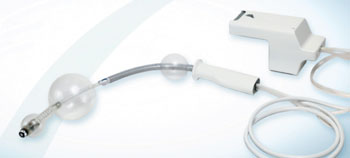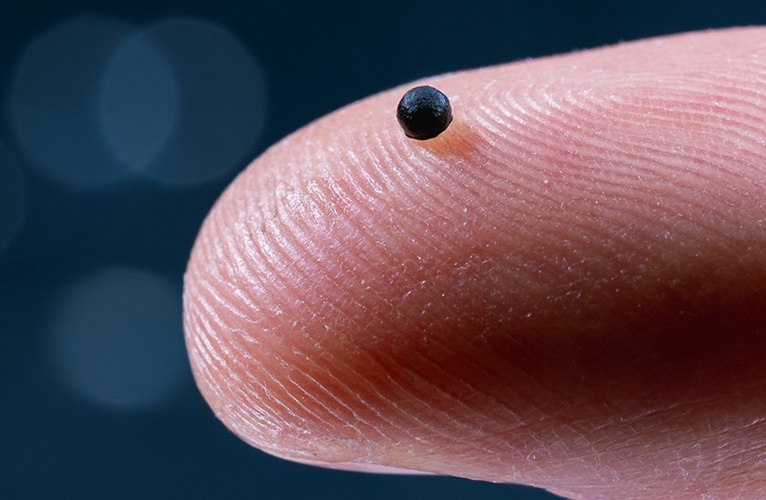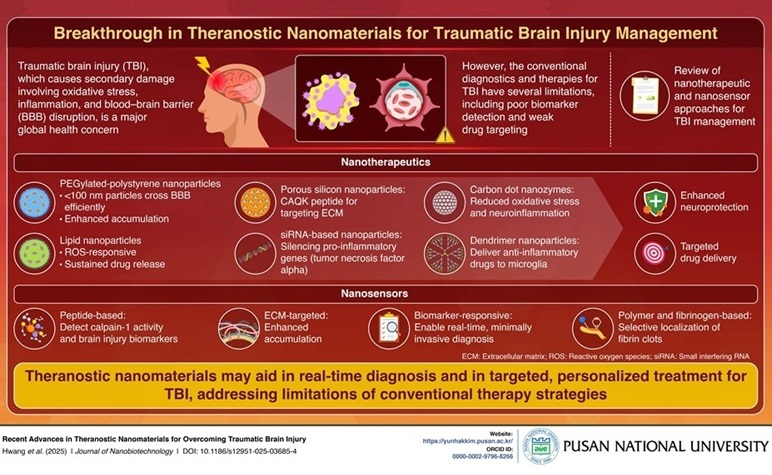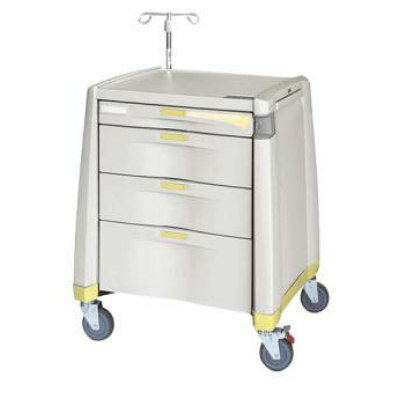Disposable Colonoscope Assists Colorectal Cancer Screening
|
By HospiMedica International staff writers Posted on 14 Dec 2014 |

Image: The Aer-O-Scope Colonoscope System (Photo courtesy of GI View).
An advanced, single use, self-propelled colonoscope offers omnidirectional colorectal cancer (CC) screening.
The Aer-O-Scope System consists of two primary components. The first is the scanning colonoscope component, with a novel optical system that maximizes visualization of the entire colonic mucosa, including behind haustral folds, thanks to advanced optics that enable 360° panoramic visualization, as well as a front view similar to that of conventional colonoscopy. A soft multilumen tube and pneumatic mechanism, directed by pressure measurement control software, makes use of balloons and low pressure CO2 to provide self-propelled intubation and advancement within the colon.
The second component is the Aer-O-Scope work station, which provides the elements to operate the disposable scanner. These include CO2, water, suction and air pressure, and the power supply for the camera and illumination. The work station also receives and processes transmitted data from the camera and scanner. The work station physician interface is equipped with an ergonomic joystick for intuitive control of navigation, insufflation, irrigation, and suction. The Aer-O-Scope Colonoscope System is a product of GI View (Ramat Gan, Israel), and has been approved by the US Food and Drug Administration (FDA).
“Aer-O-Scope is the only colorectal screening product that is single use, self-propelled and has 360° omnidirectional visualization,” said Tal Simchony, MD, CEO of GI-View. “This enables the physician to observe all the mucosa of the colon, including behind folds, which is critical for a complete colonic assessment. If a polyp is there, Aer-O-Scope will allow the physician the best possible chance of finding it.”
Colonoscopy involves the endoscopic examination of the entire large bowel and the distal part of the small bowel via the anus, and has become a primary routine screening test for CC in people who are over 50 years of age. Among people who have had an initial colonoscopy that found no polyps, the risk of developing CC within five years is extremely low, and there is therefore no need for those people to have another colonoscopy sooner than five years after the first screening.
Related Links:
GI View
The Aer-O-Scope System consists of two primary components. The first is the scanning colonoscope component, with a novel optical system that maximizes visualization of the entire colonic mucosa, including behind haustral folds, thanks to advanced optics that enable 360° panoramic visualization, as well as a front view similar to that of conventional colonoscopy. A soft multilumen tube and pneumatic mechanism, directed by pressure measurement control software, makes use of balloons and low pressure CO2 to provide self-propelled intubation and advancement within the colon.
The second component is the Aer-O-Scope work station, which provides the elements to operate the disposable scanner. These include CO2, water, suction and air pressure, and the power supply for the camera and illumination. The work station also receives and processes transmitted data from the camera and scanner. The work station physician interface is equipped with an ergonomic joystick for intuitive control of navigation, insufflation, irrigation, and suction. The Aer-O-Scope Colonoscope System is a product of GI View (Ramat Gan, Israel), and has been approved by the US Food and Drug Administration (FDA).
“Aer-O-Scope is the only colorectal screening product that is single use, self-propelled and has 360° omnidirectional visualization,” said Tal Simchony, MD, CEO of GI-View. “This enables the physician to observe all the mucosa of the colon, including behind folds, which is critical for a complete colonic assessment. If a polyp is there, Aer-O-Scope will allow the physician the best possible chance of finding it.”
Colonoscopy involves the endoscopic examination of the entire large bowel and the distal part of the small bowel via the anus, and has become a primary routine screening test for CC in people who are over 50 years of age. Among people who have had an initial colonoscopy that found no polyps, the risk of developing CC within five years is extremely low, and there is therefore no need for those people to have another colonoscopy sooner than five years after the first screening.
Related Links:
GI View
Latest Surgical Techniques News
- New Study Findings Could Halve Number of Stent Procedures
- Breakthrough Surgical Device Redefines Hip Arthroscopy
- Automated System Enables Real-Time "Molecular Pathology" During Cancer Surgery
- Groundbreaking Procedure Combines New Treatments for Liver Tumors
- Ablation Reduces Stroke Risk Associated with Atrial Fibrillation
- Optical Tracking Method Identifies Target Areas in Robot-Assisted Neurosurgery
- General Anesthesia Improves Post-Surgery Outcomes for Acute Stroke Patients
- Drug-Coated Balloons Can Replace Stents Even in Larger Coronary Arteries
- Magnetic Kidney Stone Retrieval Device Outperforms Ureteroscopic Laser Lithotripsy
- Absorbable Skull Device Could Replace Traditional Metal Implants Used After Brain Surgery
- Magic Silicone Liquid Powered Robots Perform MIS in Narrow Cavities
- 'Lab-on-a-Scalpel' Provides Real-Time Surgical Insights for POC Diagnostics in OR
- Biodegradable Brain Implant Prevents Glioblastoma Recurrence
- Tiny 3D Printer Reconstructs Tissues During Vocal Cord Surgery
- Minimally Invasive Procedure for Aortic Valve Disease Has Similar Outcomes as Surgery
- Safer Hip Implant Design Prevents Early Femoral Fractures
Channels
Critical Care
view channel
Magnetically Guided Microrobots to Enable Targeted Drug Delivery
Stroke affects 12 million people globally each year, often causing death or lasting disability. Current treatment relies on systemic administration of clot-dissolving drugs, which circulate throughout... Read more
Smart Nanomaterials Detect and Treat Traumatic Brain Injuries Simultaneously
Traumatic brain injury (TBI) continues to leave millions with long-term disabilities every year. After a sudden impact from a fall, collision, or accident, the brain undergoes inflammation, oxidative stress,... Read more
Earlier Blood Transfusion Could Reduce Heart Failure and Arrhythmia in Heart Disease Patients
Blood loss during or after surgery can place significant stress on people with heart disease, increasing the risk of dangerous complications. Transfusions are often delayed until hemoglobin levels fall... Read morePatient Care
view channel
Revolutionary Automatic IV-Line Flushing Device to Enhance Infusion Care
More than 80% of in-hospital patients receive intravenous (IV) therapy. Every dose of IV medicine delivered in a small volume (<250 mL) infusion bag should be followed by subsequent flushing to ensure... Read more
VR Training Tool Combats Contamination of Portable Medical Equipment
Healthcare-associated infections (HAIs) impact one in every 31 patients, cause nearly 100,000 deaths each year, and cost USD 28.4 billion in direct medical expenses. Notably, up to 75% of these infections... Read more
Portable Biosensor Platform to Reduce Hospital-Acquired Infections
Approximately 4 million patients in the European Union acquire healthcare-associated infections (HAIs) or nosocomial infections each year, with around 37,000 deaths directly resulting from these infections,... Read moreFirst-Of-Its-Kind Portable Germicidal Light Technology Disinfects High-Touch Clinical Surfaces in Seconds
Reducing healthcare-acquired infections (HAIs) remains a pressing issue within global healthcare systems. In the United States alone, 1.7 million patients contract HAIs annually, leading to approximately... Read moreHealth IT
view channel
Printable Molecule-Selective Nanoparticles Enable Mass Production of Wearable Biosensors
The future of medicine is likely to focus on the personalization of healthcare—understanding exactly what an individual requires and delivering the appropriate combination of nutrients, metabolites, and... Read moreBusiness
view channel
Philips and Masimo Partner to Advance Patient Monitoring Measurement Technologies
Royal Philips (Amsterdam, Netherlands) and Masimo (Irvine, California, USA) have renewed their multi-year strategic collaboration, combining Philips’ expertise in patient monitoring with Masimo’s noninvasive... Read more
B. Braun Acquires Digital Microsurgery Company True Digital Surgery
The high-end microsurgery market in neurosurgery, spine, and ENT is undergoing a significant transformation. Traditional analog microscopes are giving way to digital exoscopes, which provide improved visualization,... Read more
CMEF 2025 to Promote Holistic and High-Quality Development of Medical and Health Industry
The 92nd China International Medical Equipment Fair (CMEF 2025) Autumn Exhibition is scheduled to be held from September 26 to 29 at the China Import and Export Fair Complex (Canton Fair Complex) in Guangzhou.... Read more














